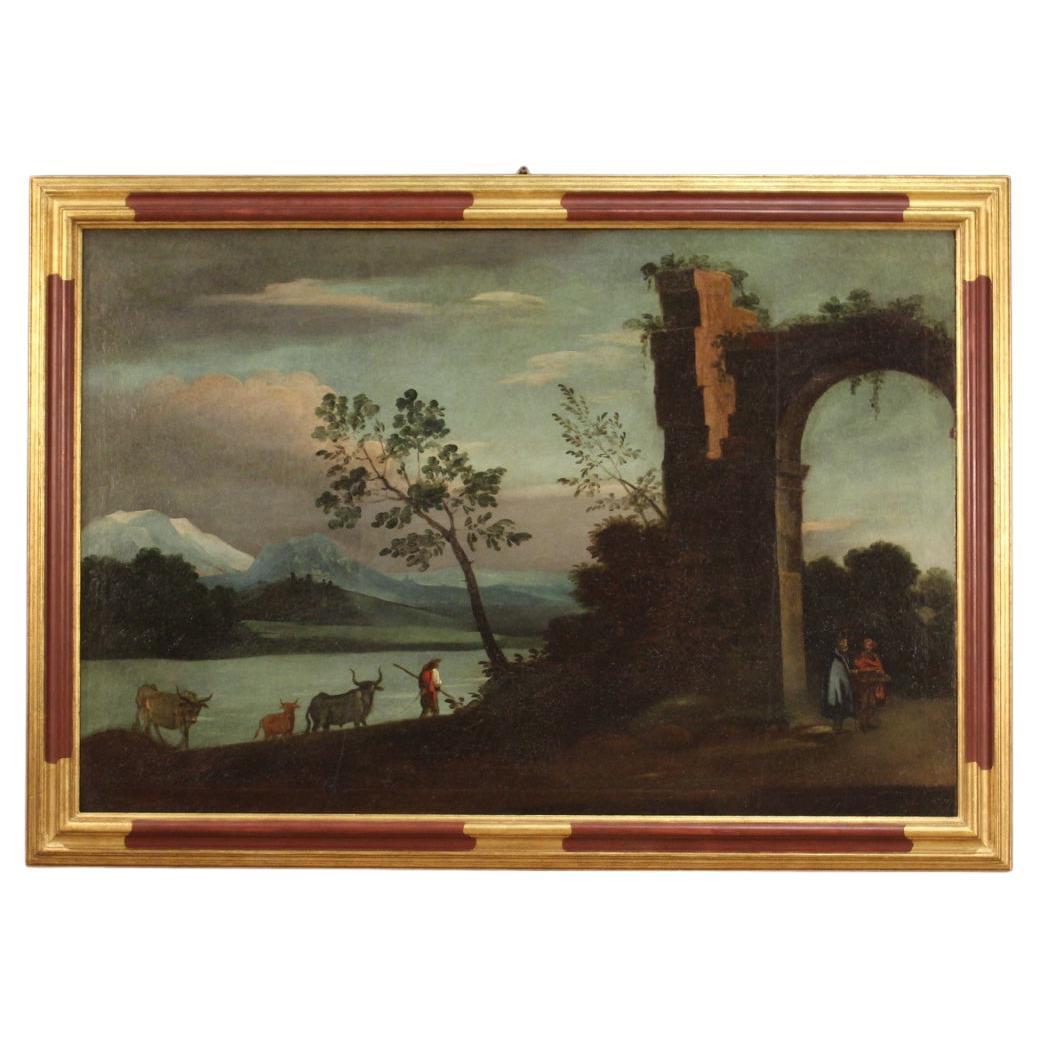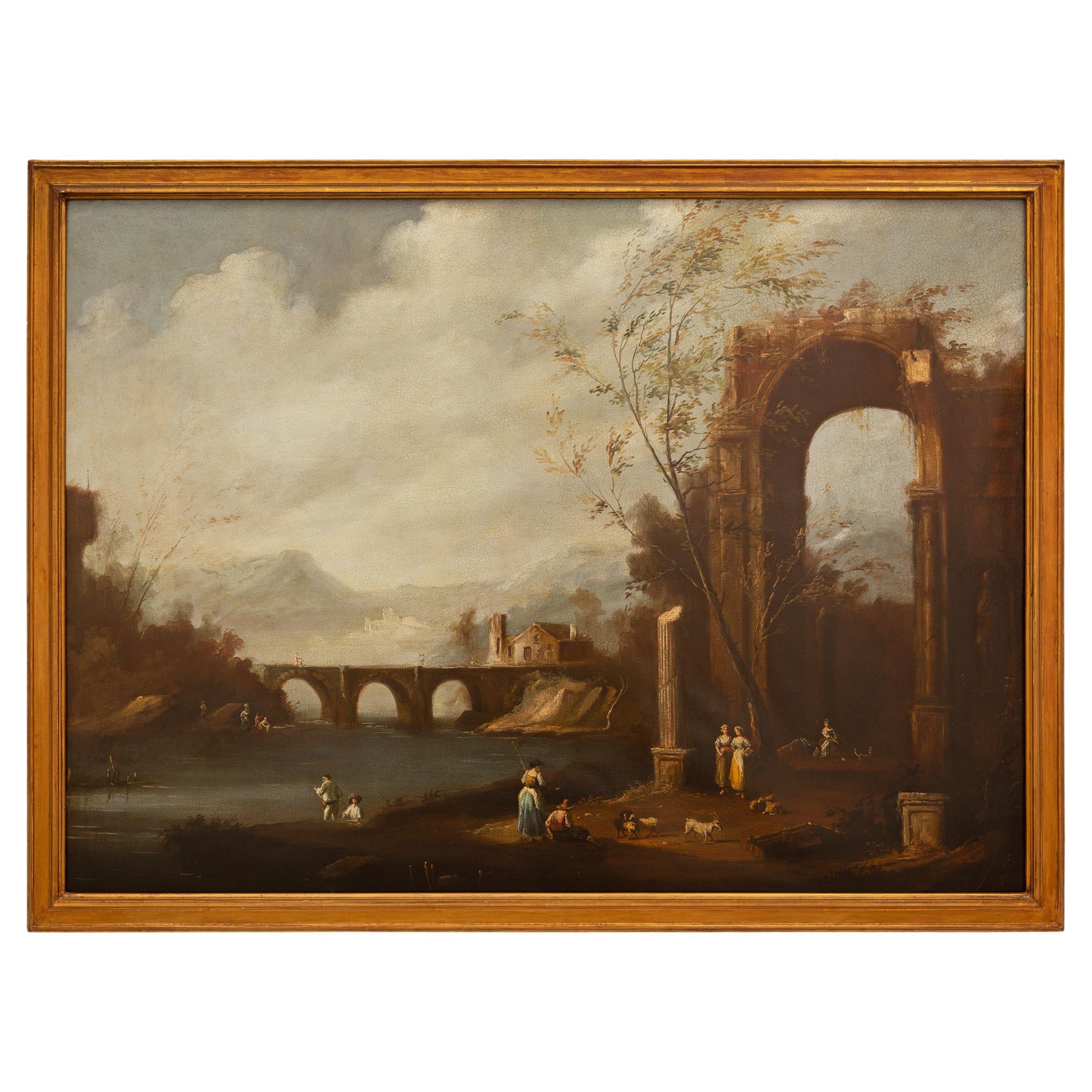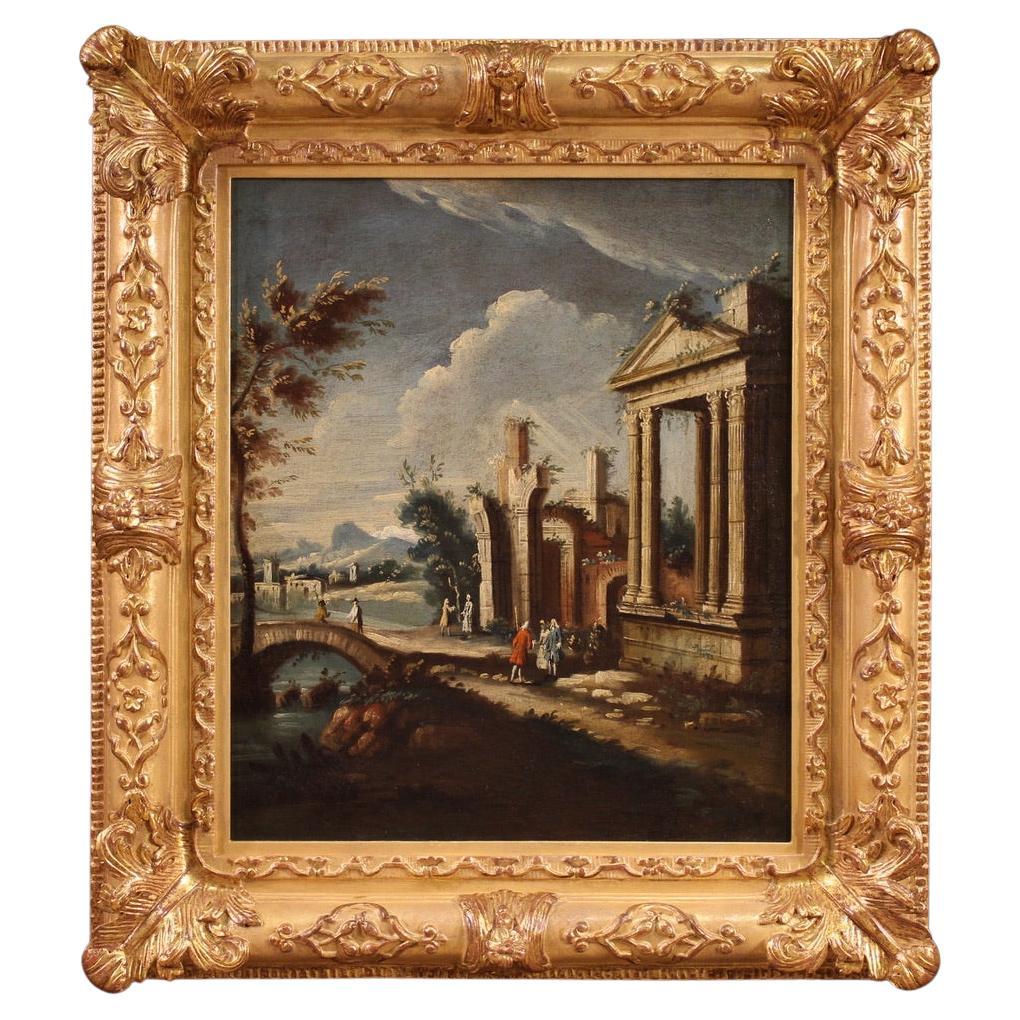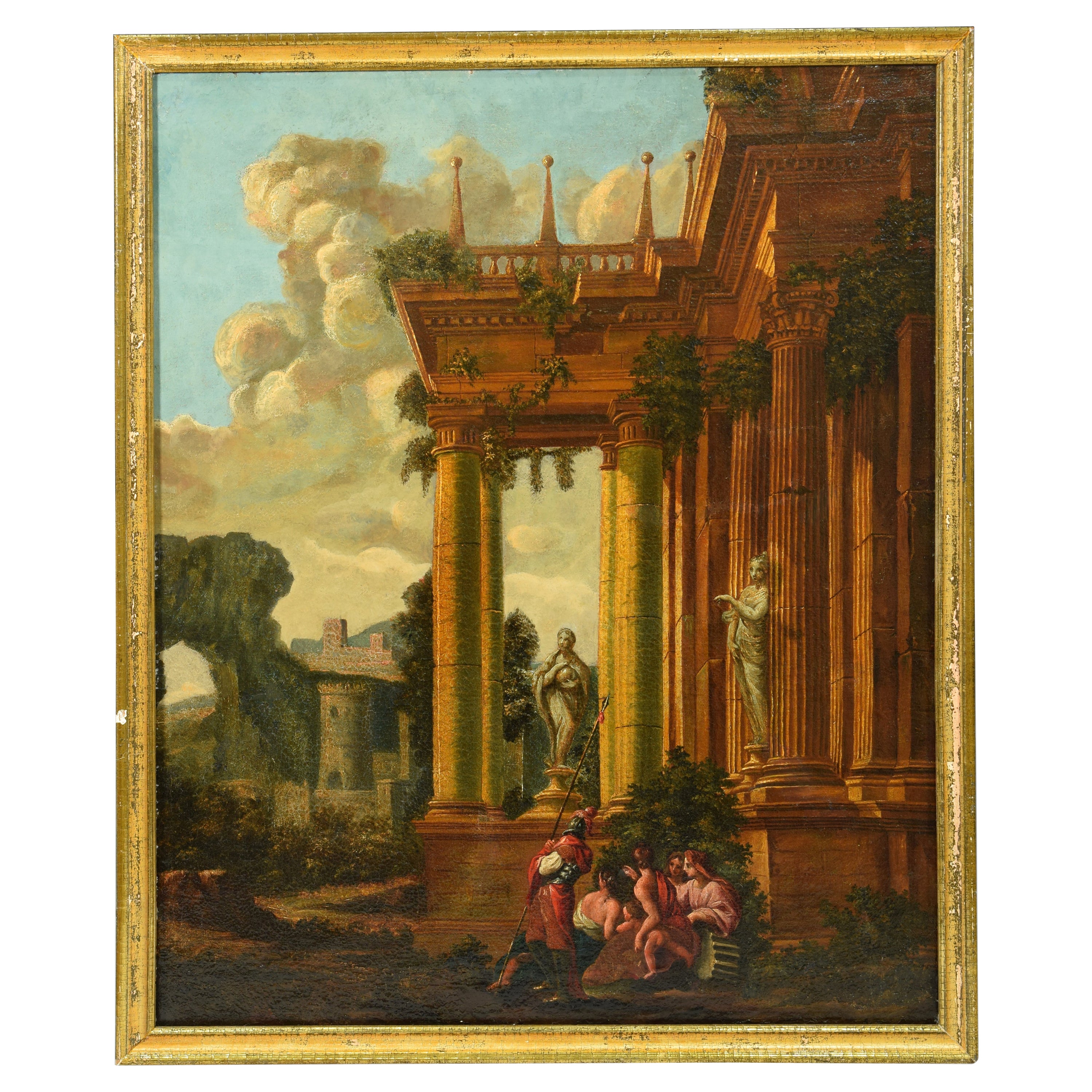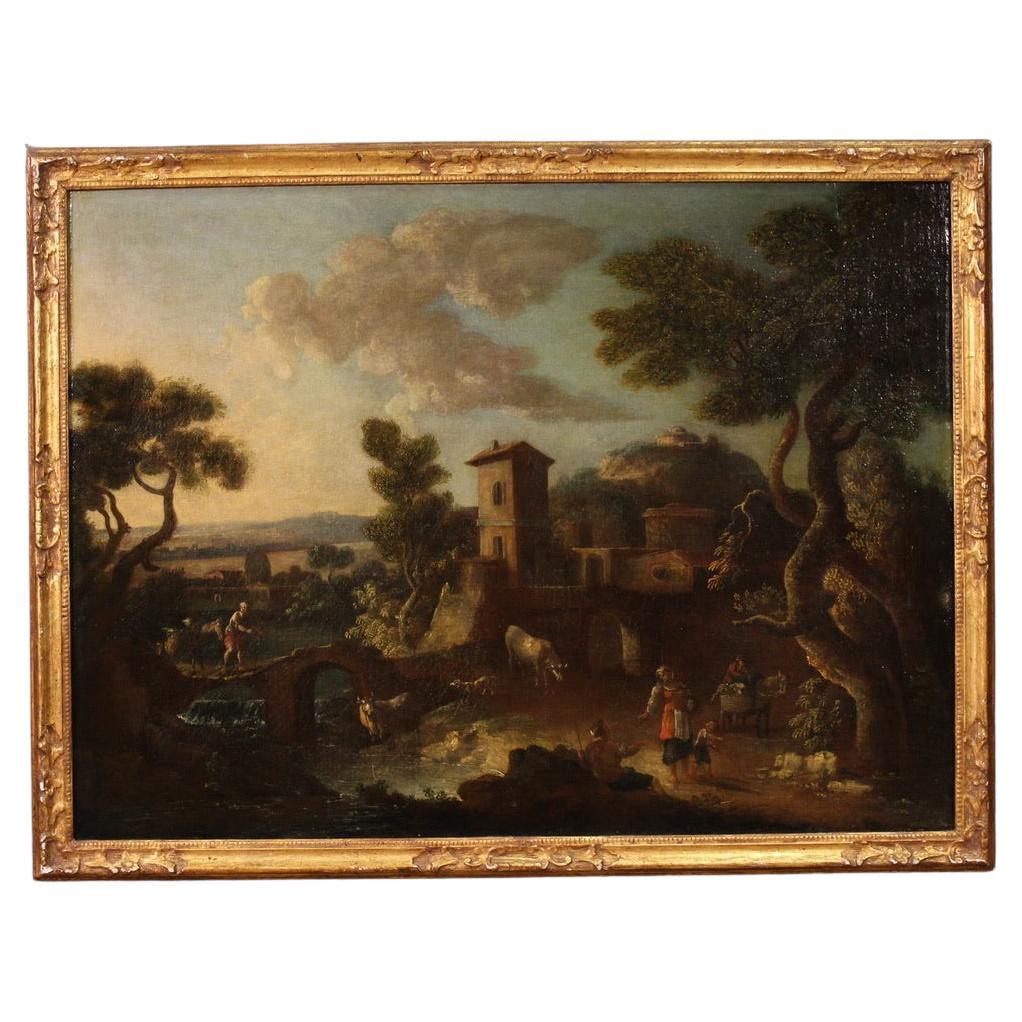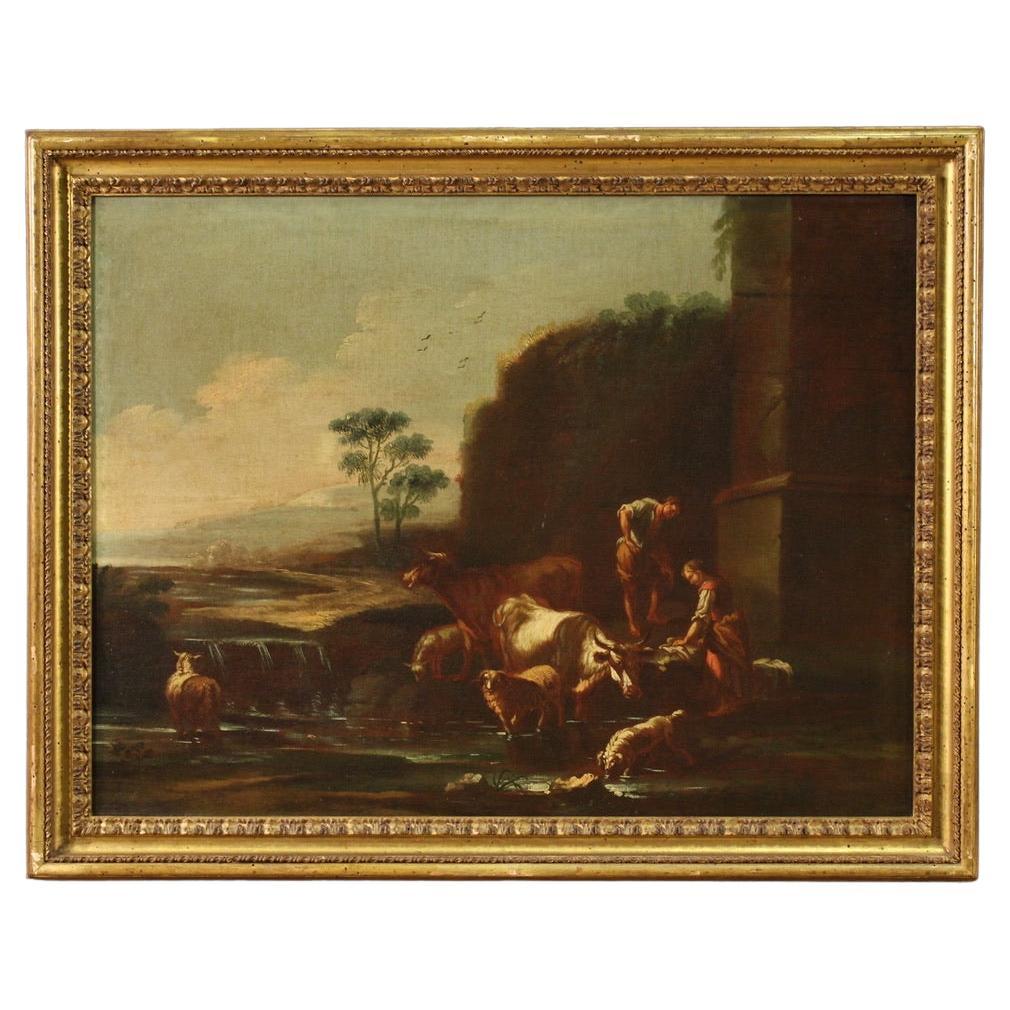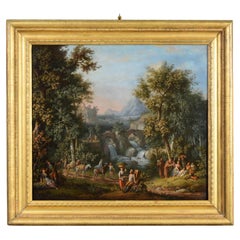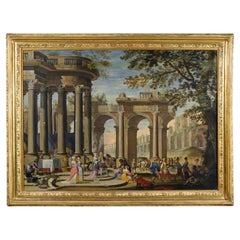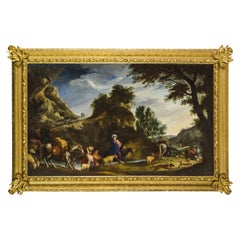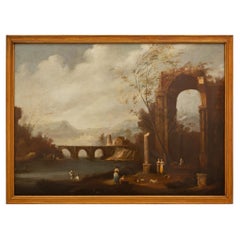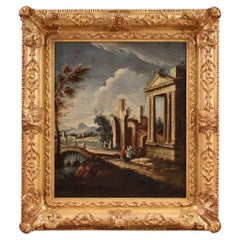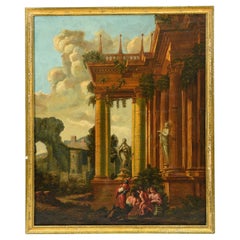Items Similar to Oil on Canvas, Roman Follower of Paolo Anesi, Landscape with Milvio Bridge
Want more images or videos?
Request additional images or videos from the seller
1 of 20
Oil on Canvas, Roman Follower of Paolo Anesi, Landscape with Milvio Bridge
$19,762.71
£14,645.25
€16,500
CA$26,979.85
A$30,013.98
CHF 15,733.70
MX$366,763.48
NOK 200,349.08
SEK 188,600.94
DKK 125,629.55
Shipping
Retrieving quote...The 1stDibs Promise:
Authenticity Guarantee,
Money-Back Guarantee,
24-Hour Cancellation
About the Item
Roman School, follower of Paolo Anesi, Roman Landscape with the Milvio Bridge, Half of the 18th Century
Oil on canvas, measures: frame cm W 149 x H 112 x D 6,5; canvas cm W 133 x H 96,5
The painting depicts a suggestive roman country landscape with the Milvio bridge crossed by some wayfarers. In the foreground, in front of the bridge, some figures liven up the scene. The bridge can be safely identified with the famous Milvio bridge, one of the oldest and most important in Rome, Italy. Originally made of wood and probably built by a censor of the gens Mulvia in the IV century BC, it was rebuilt in masonry in 109 BC, by the censor Marco Emilio Scauro. During the Middle Ages the bridge remained the main access road to Rome.
Under Pope Callisto III (1455) the wooden tower was replaced by a square tower. On June 26, 1731, the statue of Saint John of Nepomuk, depicted in the painting, was placed on the parapet of the bridge at one end of the bridge. The sculpture was commissioned to Agostino Cornacchini (Italy - Pescia, 26 August 1686 – Rome, 1754) by the Bohemian nobleman, Cardinal Michele Federico d'Althann. Saint John of Nepomuk, of Bohemian origin, drowned in Moldovan in 1393. He is considered protector of the drowned and is invoked against the floods. He is also considered protector of the secret oaths and the putto placed at the base of the statue has the index of the right hand on his mouth almost to recall the silence. The saint was canonized in 1729 by Benedict XIII and the statue was placed in 1731. It is therefore after this moment that the painting must be dated, executed anyway by the end of the eighteenth century since in the nineteenth the physiognomy of the bridge changes. In 1805 Pope Pius VII commissioned the Valadier architect of the works of accommodation.
Two lateral arches were built and the tower is renovated with the opening of the large entrance arch. In 1825, two statues were placed in front of the tower, by Francesco Mochi, from the middle of the 17th Century, and representing the Baptism of Christ. A last statue takes its place on Milvio bridge in 1840: it is the statue of the Immaculate Virgin of Domenico Pigiani placed in a position symmetrical to that of St. John of Nepomuk. The bridge, made partly jump from Garibaldi in 1849 to hinder the advance of the French, was restored in 1850 by Pius IX.
Ponte milvio is very dear to the Romans and is remembered for several historical events. In the days of the conspiracy of Catilina, Cicero had his men stationed on the bridge to set up an ambush and have the delegates of the Rooks arrested, who were in Rome to make a pact with some conspirators. The bridge was then the scene of clashes between Otone and Vitellio in 69 A.D. and still made the scene at the triumphal entrance of Settimio Severo and his troops in 193 A.D. In 312 A.D. the final story of the famous battle of Milvio bridge, fought between Maxentius and Constantine took place: after the withdrawal of the troops of Maxentius, the emperor in the attempt to cross the bridge fell into the Tiber and lost his life.
There were several eighteenth-century artists who were inspired by the charm of the ancient Milvio bridge, at a time when the Roman landscape and the ancient remains were subjects much in demand by the commissions. Among the numerous examples there is the engraving of Giuseppe Vasi, who proposes a point of view very similar to that of our canvas, and Giovanni Battista Piranesi. In both the statue of Saint John of Nepomuk has already been placed and we are before the intervention of the Valadier.
The painter should be sought after among the artists active in Rome in the mid-18th century and among the followers of Paolo Anesi.
Anesi (Rome, 9 July 1697– Rome, 1773) is one of the most important painters and engravers of the 18th century. He specializes in landscape painting and etching techniques, reproducing, with a certain freedom, the surroundings of Rome.
In the view it moves away from the analytic and documentary rule of Vanvitelliana and the decorative pomp of contemporary Giovanni Paolo Pannini and his landscapes are often enlivened by figures of wayfarers.
- Dimensions:Height: 44.1 in (112 cm)Width: 58.67 in (149 cm)Depth: 2.76 in (7 cm)
- Style:Louis XV (Of the Period)
- Materials and Techniques:
- Place of Origin:
- Period:
- Date of Manufacture:Mid-18th Century
- Condition:We apologize for any translation errors in the English text. Please find attached expertise in Italian.
- Seller Location:IT
- Reference Number:1stDibs: LU4405217043591
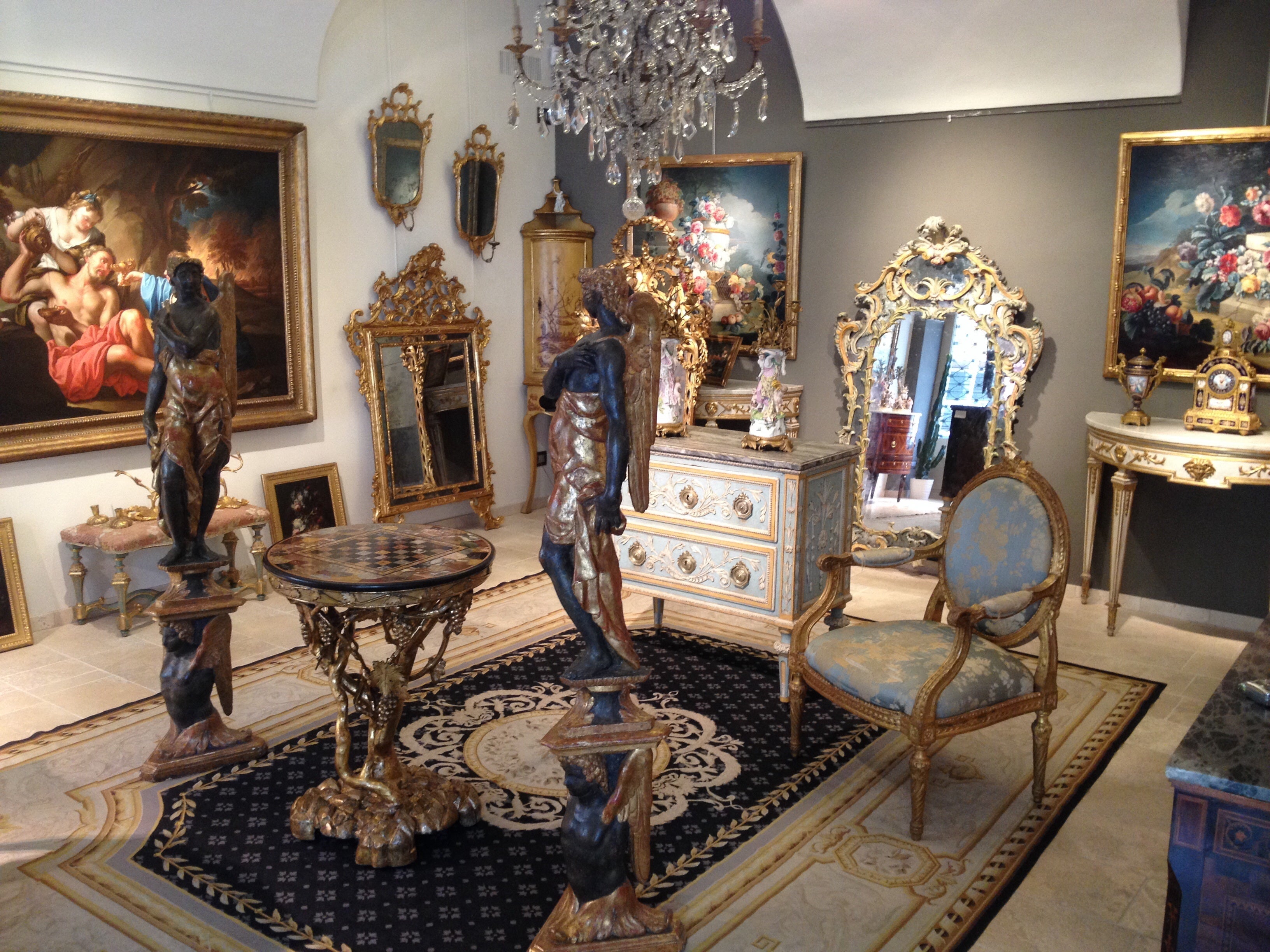
About the Seller
5.0
Platinum Seller
Premium sellers with a 4.7+ rating and 24-hour response times
Established in 1980
1stDibs seller since 2019
56 sales on 1stDibs
Typical response time: <1 hour
- ShippingRetrieving quote...Shipping from: Italy
- Return Policy
Authenticity Guarantee
In the unlikely event there’s an issue with an item’s authenticity, contact us within 1 year for a full refund. DetailsMoney-Back Guarantee
If your item is not as described, is damaged in transit, or does not arrive, contact us within 7 days for a full refund. Details24-Hour Cancellation
You have a 24-hour grace period in which to reconsider your purchase, with no questions asked.Vetted Professional Sellers
Our world-class sellers must adhere to strict standards for service and quality, maintaining the integrity of our listings.Price-Match Guarantee
If you find that a seller listed the same item for a lower price elsewhere, we’ll match it.Trusted Global Delivery
Our best-in-class carrier network provides specialized shipping options worldwide, including custom delivery.More From This Seller
View All18th Centuy, Italian Painting with Landscape by Giovanni Battista Colomba
Located in IT
Giovanni Battista Innocenzo Colomba (1713 – 1793)
Landscape with figures
Oil on canvas, Frame H 102 x L 112 x P 8; canvas H 77 x L 87
The valuable painting, attributable to the pai...
Category
Antique Mid-18th Century Italian Rococo Paintings
Materials
Canvas
$22,038 Sale Price
20% Off
18th Century, Italian Painting Depicting Landscape with Watermill and Characters
Located in IT
18th century, Italian painting depicting landscape with watermill and characters
Oil on canvas; Measurements: frame cm L 103.5 x H 127 x P 5; painting L 93 x H 117.5
The painting...
Category
Antique Mid-18th Century Italian Rococo Paintings
Materials
Canvas
18th Century, Painting Architectural Capriccio, att. to Isaac De Moucheron
Located in IT
18th Century, Painting with Architectural Capriccio with figures, attributed to Isaac De Moucheron
Measures: canvas cm H 108 x L 152; with frame cm H 132 x L 176 x 8
The painting i...
Category
Antique 18th Century Dutch Baroque Paintings
Materials
Canvas
17th Century, Italian Painting by Pier Francesco Cittadini, Jacob and his Family
Located in IT
Pier Francesco Cittadini (Milan, 1616-Bologna, 1681)
"Jacob and his family go to Egypt"
Oil on canvas, cm 109 x 190 (canvas only)
The valuable painting, made in oil on canvas, depicts Jacob and his family go to Egypt and we believe it can be, given the high quality painting, autograph work of Italian Pier Francesco Cittadini (Italy Milan, 1616 - Bologna, 1681) made after 1647. The work, in excellent condition is accompanied by a coeval frame in wood finely carved and golden.
The scene depicted, which was confused with the Flight to Egypt in the past years, is instead identified with the biblical episode of Jacob’s journey. In the foreground, reading the painting from left to right, we see a caravan composed of animals, including donkeys, dromedaries, goats, dogs and horses and people, women, men and slaves, who carry on their journey along the banks of a river, following a path that to the right, would seem to lead to the through of a bridge. In addition to the watercourse is described an environment characterized by large rocks and impervious come far to cover the entire verticality of the canvas. On the left, in the distance, we see the tail of the caravan that runs along the steep path. Large trees enliven and harmonize the environment, as well as white and grey clouds characterize the predominantly clear sky and illuminated on the right by sunlight.
The story is told in the Bible, Book of Genesis, 30, 25, passage in which is described the flight of Jacob from Haran after the contrasts with Laban, father of his wife Rachel. Jacob is the third great patriarch of the Bible. From his descendants originate the twelve generations of the people of Israel. He is the son of Isaac and Rebekah, who led him to flee from the wrath of Esau to Haran to seek refuge from his brother, Laban. At his uncle’s house Jacob met his daughter Rachel. As soon as he saw his cousin, Jacob was taken. Jacob will stay seven years in the service of Laban to marry his beloved Rachel. But Laban, with a deception, will give him in marriage first Lia, the least beautiful eldest daughter, and only after another seven years the splendid Rachel. From his first wife he will have several children, while Rachel will give birth to the beloved son, Joseph, who will become viceroy of Egypt.
After years of service, Jacob asked to be paid with every dark-coloured garment among the sheep and every spotted and dotted garment among the goats. Laban accepted and sent away from his sons all the leaders of that kind. So Jacob took fresh branches of poplar, almond and plane tree, and flayed them, and put them in the troughs. The optical suggestion induced the goats and the sheep to conceive and give birth to dark, striped and dotted garments. He also ensured that all the strongest and healthiest leaders of the flock of Laban would drink near the barked branches, thus assuring a genetic superiority to his part of the flock. His flocks grew numerous and strong and he became richer than his relative, arousing envy. It was clear that Laban would not respect him much longer. At the suggestion of the Lord, Jacob decided to return to Canaan. Trying to avoid any possible dispute, he left with his family while Laban was absent for shearing sheep. But when, three days later, his uncle returned home, he became angry, feeling offended because Jacob had gone secretly and had not allowed him to greet his daughters and grandchildren. In addition, his teraphim, statuettes, or idols, which depicted the family deities, had disappeared. After 7 days of pursuit, Laban and his men reached Jacob’s group on Mount Gilead, in the mountainous region west of the Euphrates River, where his uncle and grandson had a stormy conversation. The younger man was outraged at being accused of stealing idols and told Labano to rummage through his family’s tents at will. Neither of them could know or even imagine that it was Rachel who took the idols and hid them in the saddle of the camel. During the search, she sat down firmly on the saddle, apologizing for not being able to get up, «because I usually have what happens to women» (Gen 31:35). So the loot wasn’t discovered.
The author of this work was inspired by the composition of an engraving by Stefano Della Bella (1610-1664) of circa 1647. The engraving by Stefano della Bella bears the title "Iacob sur ses vieux jours quitte sans fascherie pour voir son filz Ioseph, sa terre et sa patrie" and is signed on the bottom left "Stef. of the Beautiful In. et fe." while on the right it is declared "Cum privil. Regis", that is with license of the king.
Stefano Della Bella (Italy - Florence, May 18, 1610-Florence, July 12, 1664) was born in a family of painters, sculptors and goldsmiths and was left early orphan of his father sculptor, he dedicated himself first to the art of goldsmith at the school of Giovanni Benedetto Castiglione and Gasparo Mola, then turning his attention to drawing and engraving. He soon began drawing figures and copying the etchings of Jacques Callot, which inspired his early works. Under the protection of the Medici, in particular of Don Lorenzo, cadet son of Grand Duke Ferdinand I, Della Bella has the opportunity to make study trips to Rome, where he stayed from 1633-1636; In Rome he met French engravers and publishers of prints such as Israël Henriet and François Langlois, who influenced his decision to move to Paris in 1639, four years after the death of Callot. In Paris he soon reached, thanks to the engravings commissioned by Cardinal Richelieu, the success also worldly; he frequented courtiers, theatre artists and writers, while refusing too oppressive honors. In 1646-1647 he continued his travels in the Netherlands to Amsterdam, Antwerp and Dordrecht. He returned to Florence in 1650 and resumed working under the protection of the Medici court, working for his patrons. In 1656 he became a member of the Academy of Apatists.
The painting object of this study is reasonably attributable to Pier Francesco Cittadini, or Pierfrancesco Cittadini, called the Milanese or the Franceschino (Italy - Milan, 1616-Bologna, 1681) as some exemplary stylistic comparisons proposed to follow can prove.
Pier Francesco Cittadini was an Italian baroque painter, mainly active in Bologna.
His artistic training first took place with the painter Daniele Crespi...
Category
Antique Mid-17th Century European Baroque Paintings
Materials
Canvas, Giltwood
18th Century, Italian Pair of Oil on Canvas Paintings by Francesco Simonini
By SIMONINI
Located in IT
Francesco Simonini (Parma, 16 June 1686 - Parma, 1766)
“The rest of the soldiers” and “The march of soldiers”
oil on canvas
cm 40 x 58 and 40 x 60 ; frame: h 52,5 x W 70,5 x D 6 an...
Category
Antique Early 18th Century Italian Baroque Paintings
Materials
Canvas
$28,027 Sale Price
35% Off
18th Century, Baroque Austran Painting by August Querfurt
Located in IT
August Querfurt (1696, Wolfenbüttel - 1761, Vienna)
Farmers and villagers at the entrance of a village
Oil on panel , cm 38,5 x 51. frame 66 x 53,5 x 4,5 cm
The valuable painting, ...
Category
Antique 18th Century Austrian Baroque Paintings
Materials
Wood
You May Also Like
18th Century Oil on Canvas Italian Antique Landscape Painting, 1750
Located in Vicoforte, Piedmont
Antique Italian painting from 18th century. Framework oil on canvas, on the first canvas, depicting a view with characters, animals and ruins of good pictorial quality. Large size fr...
Category
Antique 1750s Italian Paintings
Materials
Canvas
Italian 18th Century Oil on Canvas Painting in a Giltwood Frame
Located in West Palm Beach, FL
A beautiful large scale Italian 18th century oil on canvas painting in a giltwood frame. The painting depicts the lovely Italian countryside with charming personages dressed in class...
Category
Antique 18th Century Italian Paintings
Materials
Canvas, Giltwood
18th Century Oil on Canvas Venetian Architectural Capriccio Landscape Painting
Located in Vicoforte, Piedmont
Refined Italian landscape from the second half of the 18th century. Oil painting on canvas depicting a splendid view with ancient ruins and figures in Venetian dress, of remarkable p...
Category
Antique 1760s Italian Paintings
Materials
Canvas
Landscape with Classical Ruins, Oil on Canvas, Attributed to Giner, Vicente
Located in Madrid, ES
Landscape with classical ruins. Oil on canvas. Attributed to Giner, Vicente (ca. 1636-1681).
Reengineered (reentelado in spanish).
Landscape with rocks and buildings in the background that presents, in the foreground, constructions with a marked classicist air, accompanied by two female sculptures on two pedestals. At the foot of this building, there is a group of people, dressed in the classic way (women, children and a soldier with a spear). Vicente Giner, canon and artist from Castellón, is documented working in Rome during the last quarter of the seventeenth century (until he died here in 1681), where he requested, together with others, from Carlos II...
Category
Antique 17th Century European Baroque Paintings
Materials
Other
17th Century Oil on Canvas Italian Antique Painting Landscape with Figures, 1680
Located in Vicoforte, Piedmont
Antique Italian painting from the second half of the 17th century. Oil on canvas artwork depicting a wonderful bucolic landscape with a village, common people and grazing animals. Wi...
Category
Antique 1680s Italian Paintings
Materials
Canvas
17th Century Oil on Canvas Italian Antique Landscape Painting Pastoral Scene
Located in Vicoforte, Piedmont
Antique Italian painting from the second half of the 17th century. Oil on canvas artwork depicting a splendid bucolic landscape with figures and grazing animals, of remarkable pictor...
Category
Antique 1680s Italian Paintings
Materials
Canvas
